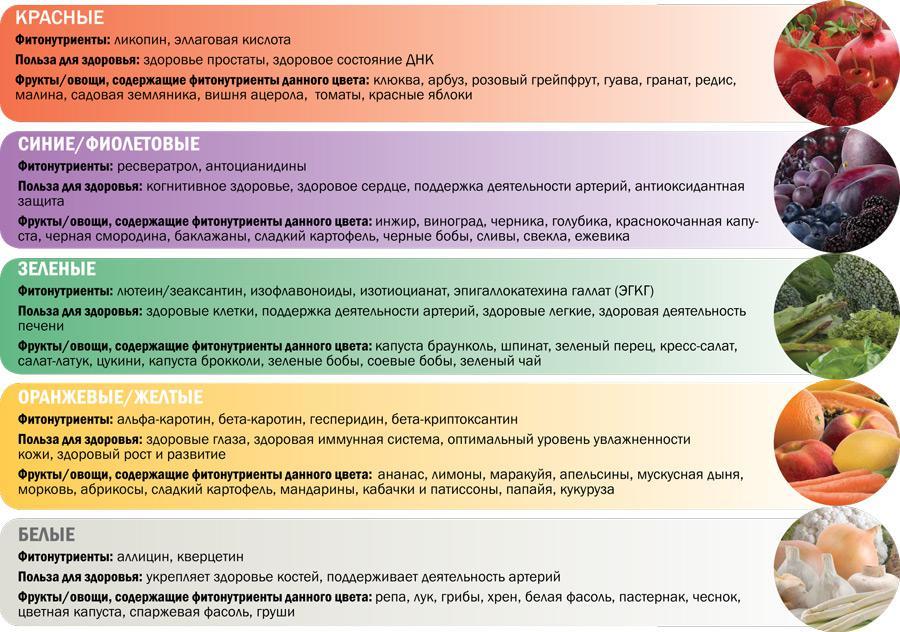The article gives the concept of healthy diet, the principles of proper food regime are collected.
Content
- The correct composition of food
- Video: TOP 10 harmful products. How to replace?
- Basic rules of healthy diet
- Video: Rules for proper nutrition
- Combined and incompatible products: compatibility table
- Separate nutrition: pros and cons of
- Healthy food: 5 colors of vegetables and fruits
- How to drink water correctly?
- Fractional nutrition
- Nutrition tips
- Video: proper nutrition. Proper nutrition for weight loss. How to eat to be healthy
The principles of a healthy diet are difficult for many. However, according to the World Health Organization, the life expectancy of a person, as well as the preservation of his activity at an advanced age by 60% depend on what and when we eat. The rules of natural nutrition are simple, and the benefits of their compliance are in the preservation of the youth of the spirit and the tone of the body, the absence of diseases.
The correct composition of food
All the food that we consume carries a certain set of substances.
These are not only proteins, fats and carbohydrates, but also a vitamin-mineral complex and water.
With the participation of the latter, almost all processes in the body pass, and its volume in the human body is up to 75%. Therefore, it is so important to make up for the fluid rate every day.
The products that we buy in the store or grow ourselves can conditionally be divided into useful and harmful. Useful are completely natural products of plant and animal origin, grown without chemical additives. Harmful include processed, modified foods full of toxic additives.
Nature has created a variety of plant and animal food, which nourishes a person and allows him to live a full life. Using semi -finished products, store sauces, pickles, canned foods, sausages, sweet soda, fast -cooking food, purified oils, margarine, etc., we replace natural “bricks” useless, and often destructive products. As a result of this, the human body suffers micro -changes that transform into serious diseases through time.
Important: diseases of malnutrition - hypertension, obesity of different degrees, diabetes mellitus, atherosclerosis, etc. It is proved that the transition to healthy food significantly reduces the manifestations of these ailments, and is also a prevention of their occurrence.
For a full existence, a person needs a balanced diet. In the absence of diseases and individual indications, the scheme of the number of nutrients for an adult for every day is as follows:
- proteins-20-30%;
- fats-20-30%;
- carbohydrates - 50%.

In addition, it is important which proteins, fats and carbohydrates we get. Here are the basic rules regarding a daily healthy diet.
- Uniform food depleted the body, so it is important to consume various products. There should be more plant food among them. The fiber contained in plants contributes to normal digestion and protects from the ailments of the heart and blood vessels. Fruits and vegetables should prevail over other products. Do not get carried away with exotic fruits. Scientists have proved that the vegetation of his native places brings more benefit to a person.
Important: a sufficient volume of plant foods controls glucose and “harmful” cholesterol in the blood, saturates the body with vitamins and minerals.
- For proper life, fats are necessary, from which, wanting to lose weight, women often refuse, which is fundamentally wrong. Fatty acids are best obtained from vegetable oils and fatty varieties of fish. But it is better to refuse heavy animal fats. Stop your choice on lean parts of birds, beef, pork, rabbit. The norm of fat should not exceed a third of the daily diet.
- Include low -fat dairy and fermented milk products in the menu. It is better not to consume completely low -fat milk and products from it, since calcium is poorly absorbed from them.
- Minimize sugar consumption. This is an absolutely useless product for the human body, which is a source of empty carbohydrates.
- Go to sea salt or buy ordinary, but with the addition of iodine. Excessive salt use increases the risk of increased pressure and development of other serious ailments. The daily dose of salt is 1 tsp, and most of this volume is contained in the finished food - bread, cheese, etc.
Video: TOP 10 harmful products. How to replace?
Important: refuse alcohol, which are not only toxic substance, but also the pathogen of appetite. The drunk person does not care about what quantities and what he “bites”.
Basic rules of healthy diet
- Chew food well. Wething with saliva is the primary processing of food, without which it will become worse.
- Eat slowly and thoughtfully so as not to overeat. A feeling of satiety comes 10-15 minutes after the meal.
- Immediately after eating, physical activity is not recommended. Rest, doing a calm job. But experts do not advise sleeping, especially driving, usually occurs due to overeating.
- Drink at least 1.5 liters of clean water per day.
- Eat often, 4-6 times a day. This will support the level of metabolism at the same level.
Video: Rules for proper nutrition
Important: experts recommend to adult 2 portions of protein per day, 3 portions of grain, up to 6 servings of vegetables and fruits, but leave only 1 portion to the choice for alcohol and sweets.
Combined and incompatible products: compatibility table
Different products are digested at different speeds, and also require their special environment for processing. When we eat vegetables, soup, bread, and dessert in the form of a cake at a time, the result of such a meal becomes a fifting food mass. Not a single product from this mass will be absorbed by 100%. That is why many experts advise dividing products into groups that are combined with each other or another.

- Sweet fruits. Compatible inside their subgroups, as well as with a subgroup of semi -acid fruits. It is optimal to eat sweet fruits is separate from other food.
- Semi-acid (sweet and sour) fruits. They are combined with all fruit categories, with sour milk products, as well as foods rich in plant and animal fats. With meat and starch -containing products, combination is not only not desirable, but also dangerous.
- Sour fruits. They can be mixed with any fruits, except for sweet, with sour milk and fat "milk".
- Vegetables that can be combined with any categories, except for whole milk. These are most vegetables.
- Vegetables that are mixed only with categories of fats, starch, other vegetables. This is cauliflower, many lying (wintering) vegetables, eggplant, green peas.
- Starch. They are combined with subgroups of vegetables, fats, with herbs.
- Squirrels. Protein cannot be mixed with milk, starch, fruits and sweet. But vegetables and greens are intoxicated by protein products and contribute to their better assimilation.
- Plant and animal fats that are better not to connect. A negative combination is made up of sugar fats. A great option is fats and fruits, berries, vegetables, starch -containing products.
- Sahara. This is sugar, fructose, honey, jam, etc. Sweet is best absorbed when eaten outside combinations with other categories.

Separate nutrition: pros and cons of
Separate nutrition is based on the table combination of products. The main provision of separate nutrition theory says that that food is useless, which, like whom it stuck in the stomach or intestines and emits toxins, instead of nourishing the body. Moreover, such food is dangerous for health, since it is deposited in the form of toxins and toxins.
Important: the most useful author of theory, Herbert Shelton calls simple food. At a time, he recommends eating one type of food or several compatible products from the combination table.
Pros of separation of products:
- detoxification of the body;
- decrease in body weight;
- fixation of body weight on one indicator (separate nutrition acts as a kind of prevention of extra pounds);
- improvement of well -being;
- increasing energetic and ability to work.
The disadvantage of theory can be called a special mode of life and a change in food habits that you need to get used to. Many doctors are against this technique, as they consider it an interference in the natural nature of human nutrition.
Healthy food: 5 colors of vegetables and fruits
Each fruit or vegetable contains certain phytonutrients. These are special natural substances, thanks to which the health, activity, youth of the human body is supported. Phytonutrients are divided into groups that surprisingly correspond to the color of the vegetable. There are 5 main colors of plant foods.
Important: the more “brighter” your plant diet, the more useful elements you get from vegetables and fruits.
How to drink water correctly?
The truth is known that water is a source of life. A person with two -thirds consists of a liquid. Moisture accompanies almost all the metabolic reactions that occur in the body. The lack of fluid affects the quality of these reactions. As a result, metabolism slows down, and a person feels himself lethargic, sleepy, irritable, his ability to work is reduced.
How much water do you need to drink per day and when to do it?
- Calculate your individual daily volume of fluid. To do this, multiply 30 ml by every kilogram of your weight.
- Drink more water in the morning and at lunch, leave a smaller part for dinner and before bedtime. If you use a lot of moisture at night, in the morning you may swell your face or swelling of the limbs will appear.
- Drink 200 ml of clean drinking water on an empty stomach before breakfast. The liquid will help wake up your body, launch metabolic processes, prepare the gastrointestinal tract for eating.
- Drink water at room temperature. Cold moisture is practically not absorbed by the body.
- For half an hour before each meal, use 200 ml of water. It is not recommended to drink food, as well as drink after it.
Important: exceptionally pure drinking water without gas is considered water. Juices, carbonated drinks, tea, coffee, broths, etc. - are also a liquid, but it is not included in the volume of those 2 liters of water that must be drunk every day.
Fractional nutrition
Fractional nutrition involves eating often, but in small portions. There are several ways of such nutrition.

The first way It consists in quenching hunger every time you felt your appetite. With this option, you can eat at least every fifteen minutes, but tiny portions-an apple, mini-toward, etc. The gastrointestinal tract is overloaded too much, since all day for it is a continuous meal. With this regime, it is difficult to monitor the balance of the diet. Therefore, experts do not recommend eating so often.
The second method It involves eating up to 6 times a day. As a rule, these are equal portions with a volume of 200 ml, which are eaten every 4 hours. In this situation, it is easy to monitor the full menu, and it is easy to enter the five- or six-time meals in your daily routine.
Nutrition tips
Remember that food is fuel for the body, and not the cult that it is erected in many people. Natural food will provide you with high -quality life, while toxic additives and modified products will award many diseases. “We are what we eat,” Hippocrates said in due time. So do not turn your stomach into a garbage bucket, but treat your body with respect.












